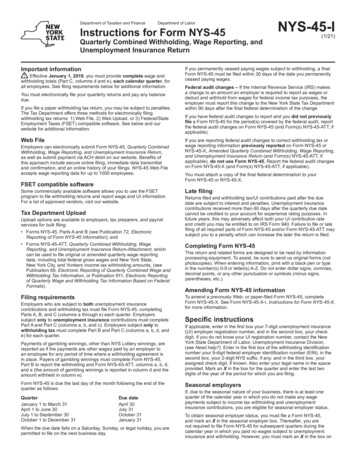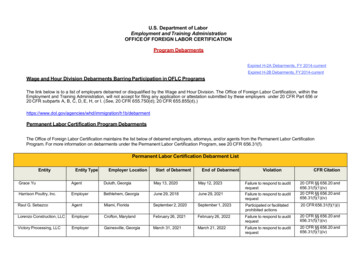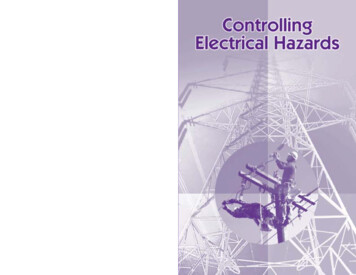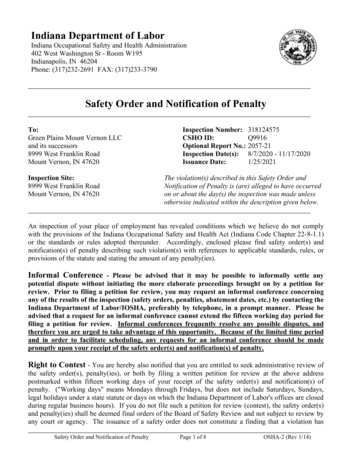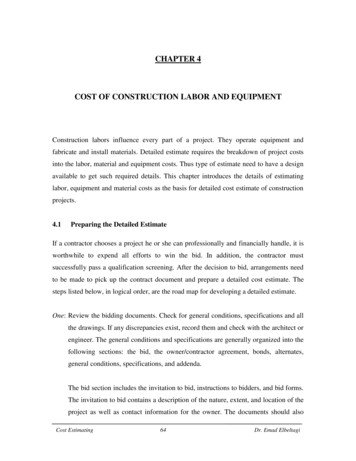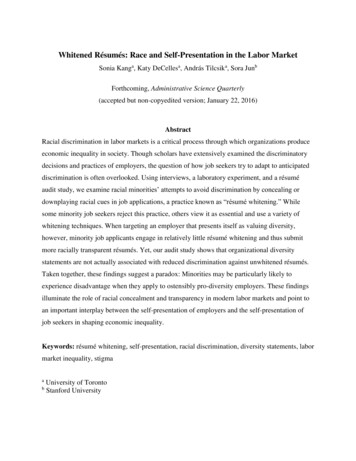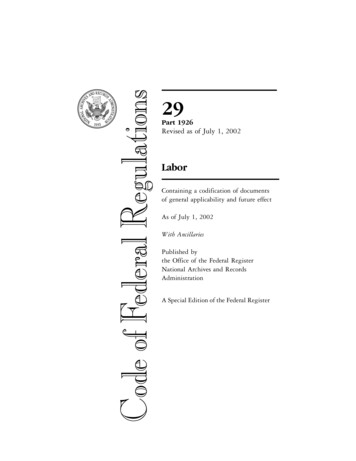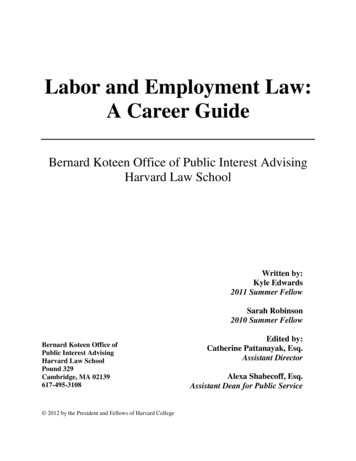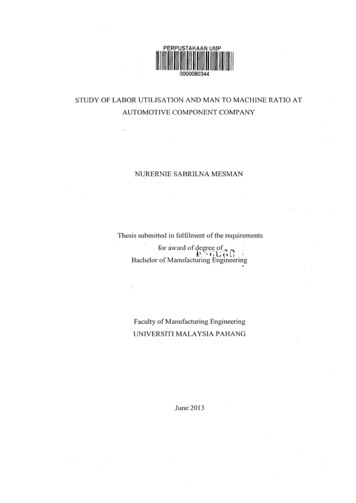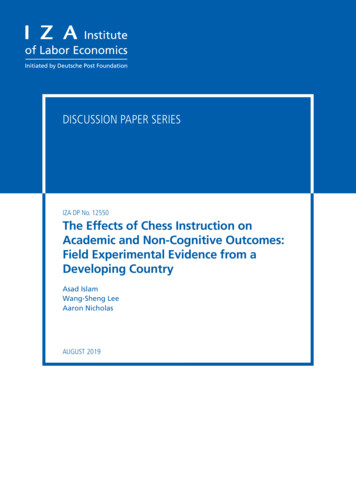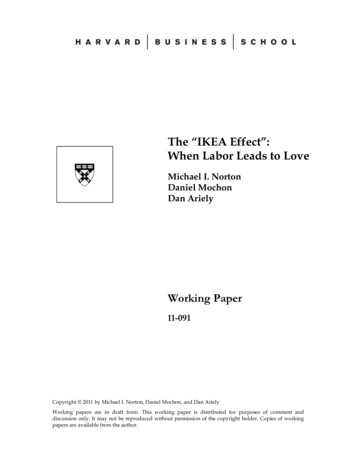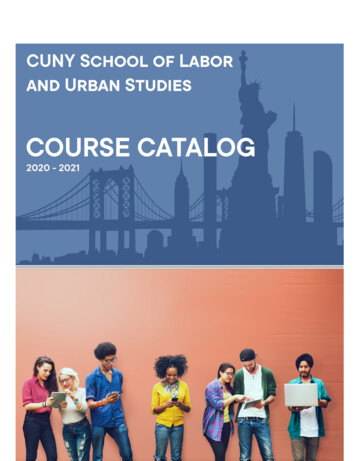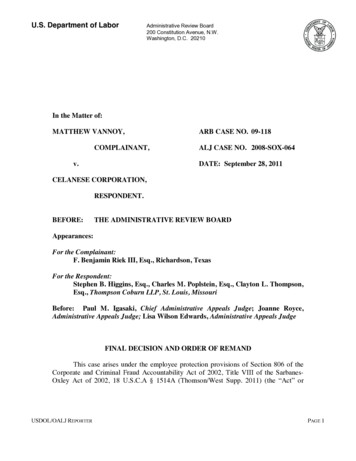
Transcription
U.S. Department of LaborAdministrative Review Board200 Constitution Avenue, N.W.Washington, D.C. 20210In the Matter of:MATTHEW VANNOY,COMPLAINANT,v.ARB CASE NO. 09-118ALJ CASE NO. 2008-SOX-064DATE: September 28, 2011CELANESE CORPORATION,RESPONDENT.BEFORE:THE ADMINISTRATIVE REVIEW BOARDAppearances:For the Complainant:F. Benjamin Riek III, Esq., Richardson, TexasFor the Respondent:Stephen B. Higgins, Esq., Charles M. Poplstein, Esq., Clayton L. Thompson,Esq., Thompson Coburn LLP, St. Louis, MissouriBefore: Paul M. Igasaki, Chief Administrative Appeals Judge; Joanne Royce,Administrative Appeals Judge; Lisa Wilson Edwards, Administrative Appeals JudgeFINAL DECISION AND ORDER OF REMANDThis case arises under the employee protection provisions of Section 806 of theCorporate and Criminal Fraud Accountability Act of 2002, Title VIII of the SarbanesOxley Act of 2002, 18 U.S.C.A § 1514A (Thomson/West Supp. 2011) (the Act orUSDOL/OALJ REPORTERPAGE 1
SOX ), 1 and its implementing regulations found at 29 C.F.R. part 1980 (2010).Matthew Vannoy filed a complaint with the Occupational Safety and HealthAdministration (OSHA) on January 25, 2008, alleging that his employer, CelaneseCorporation (Celanese) violated SOX when it terminated his employment. OSHAdismissed the complaint. Vannoy timely requested a hearing before an AdministrativeLaw Judge (ALJ) and filed an amended complaint on December 5, 2008. Prior tohearing, Celanese moved for summary decision and dismissal of the complaint, which theALJ granted on June 24, 2009. ALJ Recommended Decision and Order GrantingRespondent s Motion for Summary Decision (ALJ Decision). We reverse and remandfor an evidentiary hearing.BACKGROUNDA.FactsThe central facts in this case are quite lengthy, ALJ Decision at 1-8 & n.1, and aresummarized below.A.Vannoy s employment at CelaneseCelanese is an international publicly traded company that manufactures anddistributes value-added industrial chemicals. Celanese has a Business Conduct Policy(BCP) that governs employee conduct. Under this policy employees may anonymouslyreport suspected misconduct or legal or ethical concerns and are protected fromretaliation for good faith reporting of misconduct or participation in investigations. ALJDecision at 1-2.Celanese hired Vannoy in September 2004 as a contract employee throughVenturi Staffing Resources to assist Celanese in its efforts to catalog and reconcileemployee expense reimbursement submissions. Soon after he started working forCelanese, Vannoy noticed potential weaknesses in the company s U.S. Bank Cardprogram. By early 2005, Celanese senior management were well aware of the potentialweaknesses surrounding the U.S. Bank Card program and hired Vannoy as a full-timeemployee to serve as the Program s Administrator. Id. at 2-3.In June 2005, Celanese retained Protiviti, a third party consultant, to assist in itsanalysis of the U.S. Bank Card program and the company s expense reimbursementsystem. In September 2005, Protiviti submitted an Expense Audit and Reconciliation1During the pendency of this appeal, on July 21, 2010, the President signed into lawthe Dodd-Frank Wall Street Reform and Consumer Protection Act (Dodd-Frank Act), Pub. L.111-203, 124 Stat 1376 (2010). Sections 922(b) and (c), and 929A of the Dodd-Frank Actamended Section 806 of the SOX, but those amendments are not relevant to this case.USDOL/OALJ REPORTERPAGE 2
Project Wrap Up report to Celanese management, detailing its findings andrecommendations. In that report, Protiviti recommended that Celanese identify andimplement a new electronic system for submitting and reimbursing employee businessexpenses to address flaws or deficiencies in the system. Id. at 3.During 2006, the weaknesses in the company s U.S. Bank Card program andsteps to remedy the weaknesses were regularly discussed at meetings conducted byCelanese s Office of the Chairman (OTC). In February 2006, Celanese decided toidentify and implement an electronic system for submitting and reimbursing employeebusiness expenses to replace its U.S. Bank Card program. In December 2006, Celaneseimplemented GELCO, an electronic expense reimbursement system, to replace its U.S.Bank Card program for all U.S. based operations. Id.At some point Celanese provided Vannoy and others in his department withcompany-issued laptop computers that had remote access capabilities and allowedemployees to work from home. Throughout his tenure at Celanese, Vannoy assisted inthe company s Gap Closure project, which was designed to identify and collect missingexpense report documentation to support employee expenses charged to U.S. Bank creditcards and procurement cards, and for which Celanese paid on each employee s behalf toU.S. Bank. Id. at 3-4. Vannoy was diligent about, and understood the importance of,securing necessary information to substantiate expense report requests that Celaneseemployees submitted. See, e.g., Vannoy Dep. at 144-149. Some company employees,however, questioned [Vannoy s] efforts to secure necessary documentation, and he wascounseled about not engaging in confrontational behavior with cardholders. Id. at 4.B.Vannoy s Initial Business Conduct Policy ComplaintCelanese s BCP governs employee conduct, and under the policy employees mayreport suspected misconduct or legal or ethical concerns. On February 15, 2007, Vannoyfiled an internal BCP complaint that the company s system of administering employeecorporate credit cards, and the alleged misuse and abuse of employee credit cards, wasposing a financial risk to the company. See Resp. Motion for Summary Decision at Exh.17. On March 6, 2007, about three weeks after Vannoy filed his initial BCP complaint,he received a favorable performance review stemming from his work in 2006, and wasawarded a bonus exceeding 6,000. Vannoy also received a salary increase in the formof a Special Performance Award. Vannoy went on short-term disability leave on April 3,2007. ALJ Decision at 1, 4.During the spring of 2007, Celanese decided to phase out certain finance positionsin the United States and relocate them to Budapest, Hungary. Celanese informed Vannoythen that the transition would include his position and all others in his department. OnMay 9, 2007, Vannoy signed a retention agreement entitling him to 7,500 if he remainedwith the company until it completed the transition to Hungary. Under the agreement,Celanese would give 60 days advance notice to Vannoy (and other affected employees)as to the official employment termination date, e.g., the lay off date. Prior to signing theUSDOL/OALJ REPORTERPAGE 3
Agreement, Vannoy understood that his position with the company would expire withinthe next six to 18 months. Id. at 4.Vannoy returned from short-term disability leave in October 2007. On his returnto work, Vannoy engaged in e-mail communications with employee cardholdersregarding their submission of expense reimbursement requests and supportingdocumentation. However, Donna Tillapaugh, Vannoy s supervisor, had instructed him torefer any inappropriate communications he received from employee cardholders aboutcard charges to her attention, and not to engage in such communications himself. Id. at 4.C.Vannoy s IRS ComplaintIn February 2007, around the time Vannoy filed his BCP complaint, Vannoytalked to an attorney about his concerns over Celanese s business practices with respectto its employee credit card use program. In March 2007, Vannoy retained an attorney torepresent him in the IRS Whistleblower Rewards Program. Under this Agreement,Vannoy s attorney would receive 40% of any sum or award that Vannoy received underthe rewards program. In June 2007, Vannoy filed a disclosure as part of the IRS Rewardsprogram, that included 33 documents containing Celanese proprietary and confidentialinformation. Id. at 6.D.Vannoy s Suspension With Pay for Improper Communications WithCompany EmployeesAt some point, a Celanese employee complained to Tillapaugh aboutconversations between the employee and Vannoy concerning submission of expensereimbursements. On October 29, 2007, Tillapaugh met with Corey Fox, Celanese sGlobal Transaction Shared Services Director, to discuss the complaint against Vannoy.Together they decided to review Vannoy s sent emails to assess whether he had beencommunicating inappropriately with employee cardholders in contravention ofTillapaugh s instruction earlier that month. Vannoy did not believe it was inappropriatefor Tillapaugh to conduct this review because Vannoy s laptop warned at log-on thatemployee activities could be monitored and that unauthorized use of the company e-mailsystem could result in prosecution. Later that day, Celanese suspended Vannoy with paypending further investigation. Id. at 4-5.22The record is somewhat unclear on the purpose of the October 29, 2007 meeting.While the ALJ found that the meeting s purpose was to discuss inappropriatecommunications, the ALJ does not indicate what those communications entailed. Vannoy sdeposition states that the purpose of the October 29, 2007 meeting was to discuss Celanesemanagement s preliminary findings that Vannoy had transferred employee personnel data toa computer outside the company. Vannoy Dep. at 202-205; Zarinah Curry Aff. at 1.USDOL/OALJ REPORTERPAGE 4
E.Vannoy s Suspension Without Pay for Improperly Accessing andRemoving Personal Employee DataIn early November 2007, Celanese discovered that Vannoy had sent a documentcontaining 1,600 unique social security numbers of current and former Celaneseemployees to the personal e-mail account that was in the name of Vannoy s domesticpartner. Vannoy admitted in his deposition that in 2005 and then in 2007, he took, eitherby e-mail or on compact discs, business documents related to company operations andthat containing sensitive personal identifying information of former and current companyemployees. Vannoy Dep. at 194-195; see also ALJ Decision at 5-6. Vannoy did not askfor the company s permission, nor did he inform the company that he had removedconfidential and sensitive documents before company officials discovered the datasecurity breach. Vannoy was aware of the confidential nature of the information he hadaccess to, including employee credit card information and personal identifyinginformation such as employee home addresses and social security numbers. Id. at 5-6.Vannoy agreed to the company s confidentiality agreement in May 2005 when hewas hired as a full-time employee. Vannoy was also fully aware of the company s BCPand the precaution that employees use the company s email and Internet access only inaccordance with the Company s Electronic Communications Policy. Vannoy was alsoaware of company policies related to data security and the requirements that employeesguard the personal data of employees. Id.On November 5, 2007, Celanese converted Vannoy s suspension to without paybased upon its discovery of evidence that he violated company policies. Vannoysupplemented his BCP complaint with additional information on November 8, 2007. Id.at 5.F.Celanese s Investigation of Vannoy s BCP ComplaintThe company investigated Vannoy s BCP complaint and supplemental complaint.Vannoy did not participate in the investigation, and Celanese terminated his employmentin January 2008, after he refused for a second time to participate in the investigation.ALJ Decision at 19.On February 5, 2008, the company sent Vannoy a letter addressing the issues heraised. Id. at 7; see also Resp. Mot. For Summary Dec., Exh. 26. The report observedthat the company had already acknowledged that the previous expense reporting systemwas deficient and had taken significant actions to remedy the situation before Vannoy sBCP complaint. The report further observed that management was aware of employeemisuse of company credit cards and had given the matter attention, and that Vannoy wasaware of the large number of activities that were going on in the Company to address theissue in the time before he filed his BCP complaint. The investigation also analyzedVannoy s supplemental complaint and concluded that the supplement raised no violationsof company policy or IRS regulations. Id.USDOL/OALJ REPORTERPAGE 5
Celanese completed the transition of Vannoy s former department to Budapest,Hungary by March 2008. ALJ Decision at 4.B.Administrative Proceedings BelowThe ALJ issued his decision on June 24, 2009, and dismissed Vannoy scomplaint.1. Protected Activity. The ALJ determined that Vannoy did not engage inprotected activity. The ALJ determined that even though Vannoy filed a BCP complaint,filed a disclosure with the IRS, and voiced several complaints to his managers, he failedto allege a violation that definitively and specifically relates to one of the six enumeratedcategories considered under 1514A. The ALJ also determined that Vannoy did not havea reasonable belief that the conduct he was reporting violated one of the enumeratedcategories. The ALJ found that Vannoy s disclosure to the IRS is not a complaint to afederal regulatory or law enforcement agency as contemplated by 1514(A). ALJDecision at 13. The ALJ determined that Vannoy s complaints to the company centeredon violation[s] of the Internal Revenue Code § 162 and other IRS regulations dealingwith business expenses. ALJ Decision at 14-15, citing EX-1, pp. 123, 161-162. TheALJ concluded that Vannoy s reporting was based on his belief that Celanese wasengaged in improper accounting practices, [and that the company] was taking improperbusiness expense deductions which led to a tax windfall, and did not relate to SOXprohibitions. Id. at 14.The ALJ also determined that there was no evidence that Vannoy believed thatCelanese had committed fraud when he made his complaints. Id. at 14. Based onVannoy s deposition statement, the ALJ determined that there was no evidence ofVannoy s belief that Celanese was violating any SEC rule or regulation when he filed thecomplaint, or that Vannoy had any belief that Celanese s actions amounted to an actualfraud on shareholders. Id. The ALJ found that Vannoy s assertions were based onconduct that could potentially cause fraud. Id. The ALJ determined, however, that thebelief and presence of fraud is essential for SOX violations. Id.The ALJ determined that Vannoy failed to allege any violation that would have amaterial, adverse outcome to shareholders. Id. at 15. The ALJ observed that there isno mention of any affect on shareholders within [Vannoy s] BCP complaint and noevidence has been provided to suggest that the complaints made to his superiors involvedconduct that adversely affected the [Celanese] shareholders and that some form ofscienter related to fraud against shareholders is required. Id. at 15-16.The ALJ also determined that reporting to the IRS does not constitute acomplaint to a federal regulatory or law enforcement agency as contemplated by1514(A). Id. at 17. The ALJ observed that while Vannoy s BCP complaint, along withUSDOL/OALJ REPORTERPAGE 6
the verbal concerns that he raised with his supervisors would fall under the auspices ofSOX, the IRS complaint would not. Id. at 17.2. Unfavorable Personnel Action. The ALJ determined that Vannoy was notterminated because he filed a BCP complaint or complained to his supervisors. Id. at 18.The ALJ found that Vannoy received performance bonuses after he filed his BCPComplaint and that he remained with the company for a period of time after filing theinternal complaint and the disclosure to the IRS. Id. The ALJ found that the evidenceshowed that Vannoy s complaints towards his supervisors were taken under advisementfor over a year, and used to install new policies and programs with regards to the T&Eexpense reports. Id. The ALJ found that instead, Vannoy was scheduled to beterminated based on a business decision to outsource Vannoy s division and thatVannoy had full notice of this decision prior to his termination. Id. The ALJ found thatprior to Vannoy s outsourcing date, he engaged in conduct that was in direct violation ofcompany policies by misappropriating several employees personal identifiableinformation in violation of company policies, which are in line with state and federallaw and were known by [Vannoy] at the time of their violation. Id. at 19. Based onthese findings, the ALJ concluded that Vannoy did not suffer an unfavorable personnelaction due to a protected activity. Id.3. Contributing Factor to Unfavorable Personnel Action. The ALJ determinedthat Vannoy failed to show that he engaged in protected activity that was a contributingfactor to an unfavorable personnel action. The ALJ determined that there wasinsufficient evidence in the record to support an inference of retaliatory discrimination.Id. at 20. In support of that determination, the ALJ found that Vannoy had remained withthe company months after he began complaining to his supervisors, that he receivedbonuses after his initial BCP complaint, that he knew in advance that his position wouldbe outsourced, and that he signed an agreement to remain with the company until thetransition process was completed. Id. The ALJ determined that Vannoy was insteadterminated based on his own actions, including inappropriate communications withcompany employees, and disclosing and attempts at confiscating personal identifyingdata on thousands of company employees. Id. The ALJ found that a Protiviti AnalysisReport revealed that a portion of the confidential information that was sent tounauthorized emails and burned to compact discs were not included in [Vannoy s]disclosure to the IRS. Id. at 20-21. The ALJ noted Vannoy s deposition statement inwhich he stated that he knew of [Celanese s] policies and procedures prior to hisactions, and further knew that he was breaking these procedures by emailing and copyingthese personal identifying numbers. Id. at 21, citing EX-1, at 194-195.4. Same Adverse Action. The ALJ further observed that even if Vannoy hadengaged in protected activity, there is clear and convincing evidence that Celanesewould have taken the same unfavorable personnel action in this case terminatingVannoy, in the absence of protected behavior. Id. at 21. This determination is basedon the ALJ s finding that Vannoy participated in a breach of confidential informationwithout [Celanese s] knowledge or permission in direct conflict with [the company s]USDOL/OALJ REPORTERPAGE 7
business policies. Id. Vannoy s actions caused Celanese to spend sums of money tocontact all employees whose information had been breached and to safeguard thisinformation. Id. at 21-22.The ALJ rejected Vannoy s informer s privilege defense. The ALJ held thatSOX allows for the reporting of violations but not for illegally obtaining documents.Id. at 22, citing JDS Uniphase Corp. v. Jennings, 473 F. Supp. 2d 697 (D. Va. 2007).The ALJ observed that the informers privilege is more in line with an employee beingable to subpoena for documents that may contain confidential information.ALJDecision at 22.JURISDICTION AND STANDARD OF REVIEWThe Secretary of Labor has delegated to the Board her authority to issue finalagency decisions under the SOX. Secretary s Order No. 1-2010 (Delegation of Authorityand Assignment of Responsibility to the Administrative Review Board), 75 Fed. Reg.3924 (Jan. 15, 2010). The Board reviews an ALJ s grant of summary judgment de novo.Reamer v. Ford Motor Co., ARB No. 09-053, ALJ No. 2009-SOX-003, slip op. at 3(ARB July 21, 2011). The standard for granting summary decision is essentially thesame as the one used in Fed. R. Civ. P. 56, the rule governing summary judgment in thefederal courts. Id. Under 29 C.F.R. § 18.40(d)(2010), the ALJ may issue summarydecision if the pleadings, affidavits, material obtained by discovery of otherwise, ormatters officially noticed show that there is no genuine issue as to any material fact andthat a party is entitled to summary decision.DISCUSSIONSection 806 of the Sarbanes-Oxley Act, protects from retaliation employees ofcover
implemented GELCO, an electronic expense reimbursement system, to replace its U.S. Bank Card program for all U.S. based operations. Id. At some point Celanese provided Vannoy and others in his department with company-issued laptop computers that had remote acc
